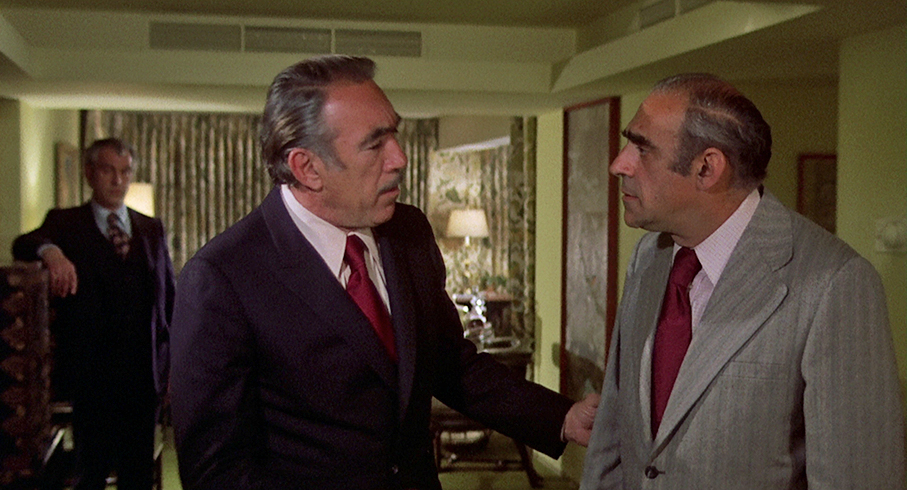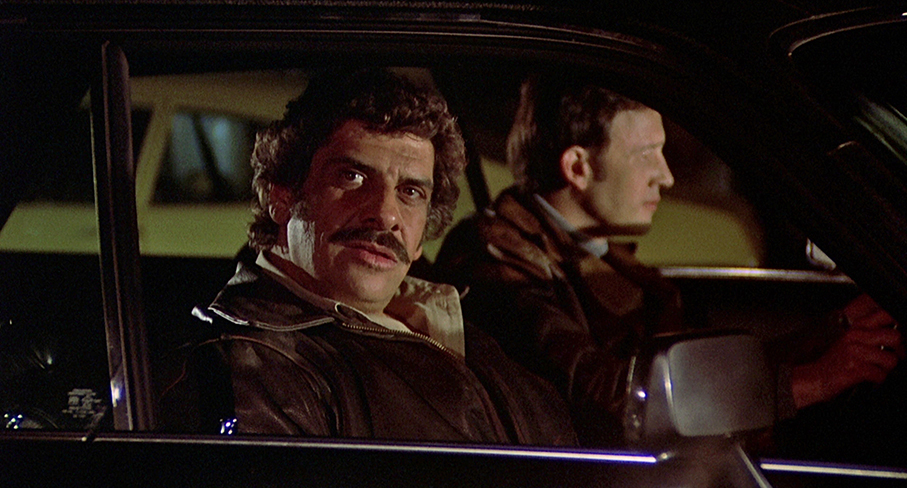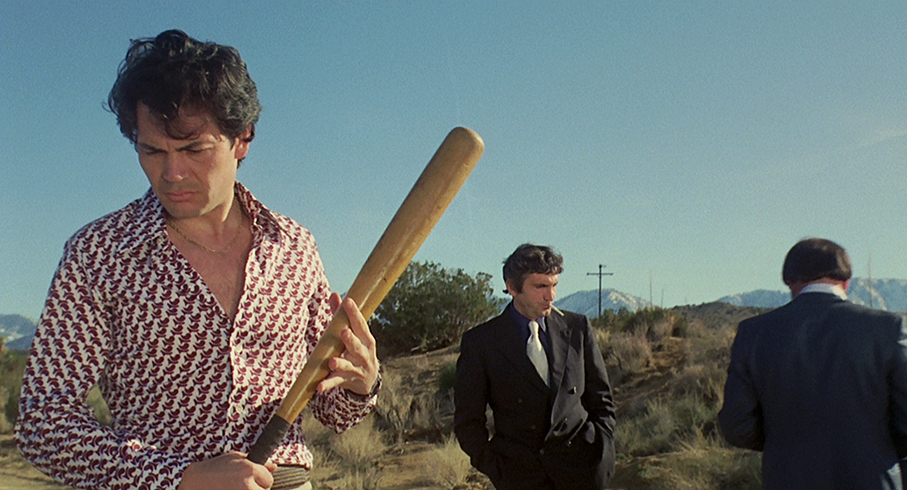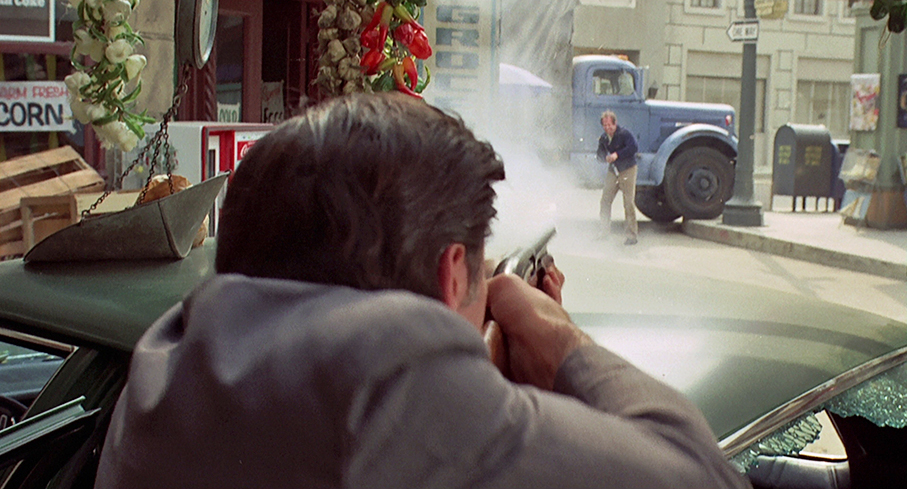|
The 1973 crime drama The Don is Dead opens with a rather neat bit of audience misdirection. In the dark of night, two men are shown waiting silently in an unlit upstairs room overlooking the street, from where they observe the arrival of a car from which two very shifty-looking men emerge. Movie convention tells us that these new arrivals are criminals being unknowingly watched by two detectives, who are going to either hold their position to see what the men do or call in the patrol cars they have sitting in waiting. It’s then that things take an unexpected turn. The car passenger enters a nearby phone box and waits, and one of the watching men then puts in a call, but not for police reinforcements as expected but to the very call box in which the goon is waiting. No words are audibly exchanged but it’s clear both parties have made contact, and the two observers are soon in the street and driving away with the other two men. Are these undercover cops working a case against unknowing criminals? Could be. A short while later they pull into an old barn and a spare wheel is removed to reveal a sizeable cache of drugs that the two observers test for authenticity and hand over a suitcase full of cash for. Then, out of the blue, three armed men with stockings over their faces appear and attempt to ambush the operation, but their actions are quickly foiled by a hidden figure in the rafters who opens fire on these would-be robbers, giving the observers the chance to grab their own weapons and finish them off. “My brother Vince,” explains one of the observers with a grin. “A little insurance.”
The drug deal turns out to have been for real and was conducted by Frank Regalbuto and one of his enforcers, Tony Fargo, with timely backup from Tony’s brother Vince. Frank is the son of mob boss Don Paolo Regalbuto, one of three that runs all of the rackets in this unspecified American city, the other two being Don Angelo DiMorra and Don Aggimio Bernardo. Almost as soon as Frank returns to home base he is informed by his father’s consiglieri, Vito Riccobono, that Don Paolo has died of a heart attack, and as a result, representatives of all three families are called to a meeting on neutral territory in Las Vegas. Frank is accompanied by Tony, Vince and Vito, while the currently imprisoned Don Aggimio is represented by his consiglieri, Luigi Orlando, whom he has left in charge of his business interests. Although Frank has inherited his father’s estate, Orlando suggests that he is currently too inexperienced to run his businesses and proposes that they instead be shared equally between the DiMorra and Bernardo families. The older and more experienced Don Angelo agrees, but also proposes that he treat Frank as the son he never had, which would later allow him to take charge of the DiMorra organisation. The Fargo brothers, meanwhile, have requested that they be allowed to go their own way as independents, and while Don Angelo also supports this move, he does so on condition that they can still be called upon for help if they are needed. With his options narrowed, Frank accepts the deal, but it turns out that Orlando has other ideas and has been plotting with Don Aggimio’s avariciously ambitious girlfriend Marie to put the rival families out of business and take control of their empires.

The Don is Dead is one of a slew of mob-themed crime movies made in the wake of the phenomenal success of Francis Ford Coppola’s The Godfather, which set a standard for the subgenre that precious few subsequent films were even able to approach, let alone match. Just about every one of these movies was – and to a degree, still is – inevitably compared to Coppola’s mafia masterpiece, and it says something that the only one to have been championed as its equal and to even have topped it in decade in which it was made was Coppola’s very own sequel, The Godfather, Part II. That such comparisons are made may in retrospect seem a little unfair, but it’s worth remembering not only that most of these films owe their very existence to The Godfather’s critical and commercial success, but that its resulting influence on them makes it hard not to pit at least some aspects of each against the other.
That said, despite some visible recycling of elements from Coppola’s film – from Don Angelo’s disapproval of profiteering from the drug trade to a sequence in which one group takes violent action to consolidate its position by wiping out key opponents – The Don is Dead tends to go its own way with what was then a relatively new subgenre of the crime movie. A quick look at the credits can’t help but fire expectations. It was directed by Richard Fleischer immediately after making the cult science fiction film, Soylent Green, was shot by that film’s cinematographer Richard E. Kline (whose credits also include Hang 'Em High, The Andromeda Strain and Star Trek – The Motion Picture) and was scored by none other than Jerry Goldsmith, example credits for whom I should not have to supply. It also has a belter of a cast that includes Anthony Quinn, Robert Forster, Frederic Forrest, Al Lettieri, Abe Vigoda, Angel Tompkins, Barry Russo, Joe Santos, Victor Argo and Sid Haig. That Lettieri and Vigoda were also in The Godfather – the instantly recognisable Vigoda in the key role of Tessio – only serves to strengthen the connection with Coppola’s film.
Although it does eventually stand on its own feet, The Don is Dead does take a while to break free from the genre-defining shadow cast by Coppola’s movie, which may or may not be partly down to restrictions of a budget I’ve not yet been able to find definitive details of. The film certainly lacks The Godfather’s sense of scale, and I’m not just talking about the absence of a grand opening wedding scene – there’s never a real indication that even a man of Don Angelo’s apparent position and influence is in command of more than a handful of men, and as a result, the criminal organisations here feel less like mafia families than small criminal gangs. The script, by Marvin H. Albert (with adaptation assistance from Christopher Trumbo and Michael Butler) from his own novel, also lacks Coppola and Mario Puzo’s poetic ear for thoughtful and smartly suggestive dialogue and too often feels little more than functional – I wasn’t too surprised that at the time of writing the film’s IMDb page was still empty of memorable quotes. This, combined with a plot that is already on the move when the film begins, also results in lead characters that don’t have a great deal of depth, and for the first third of the film I wasn't quite sure who I was supposed to be rooting for.

The cast is certainly a key draw here. Anthony Quinn brings a quiet authority to the role of Don Angelo, portraying him as an essentially decent man whom you suspect from the off could still lash out dangerously if the situation demanded, though he’s also not above giving into temptation when it walks up and sits in his lap. Just four years after his superb performance as a TV news cameraman in Haskell Wexler’s masterful Medium Cool, Robert Forster proves to be savvy casting as Frank, having as he does the air of an impulsive tough guy who hasn’t yet learned what it takes to command at the level of his adoptive godfather. He’s also got a really memorable final scene that showcases Forster’s ability to convey so much with so little when required. Despite an old-school gangster nasal Brooklyn twang, Frederic Forrest’s portrayal of Tony Fargo has just the right ‘younger brother’ feel, and he convinces completely in both his early desire to leave the business and the ruthless determination with which he later turns on those whom he believes have wronged him. If I had to pick a favourite performance here, however, it would have to be Al Lettieri as Tony’s older brother Vince. Lettieri was an actor who was too often limited by the roles in which he was cast, primarily finding himself playing take-no-crap tough guys and menacing criminals. Yet he played them to perfection and was able to intimidate or suggest violent intent with a single look or gesture, and do so with a naturalism that made it easy to believe what you were watching was real and not in any way rehearsed or performed. The women, on the other hand, get a bit of a raw deal. As Marie, Jo Anne Meredith is there only to nag Luigi about their plan, while Angel Tompkins, as Frank’s singer-songwriter girlfriend Ruby, is on board primarily to seduce Don Angelo and then get jealously beaten six ways from Sunday by Frank when he inevitably finds out.
Perhaps my biggest problem lies with the character of Luigi Orlando and the plot he has hatched with Marie to take over all of the city’s organised crime. There’s absolutely no doubt Charles Cioffi is a fine screen actor (the very same year he proved his worth in Francesco Rosi’s crime drama Lucky Luciano), but I never really bought him here as the consiglieri to a mafia crime boss. Indeed, if I was being harsh I’d suggest that he feels more like Don Aggimio’s tailor than his most trusted adviser, while his plotting with the overambitious and irritably impatient Marie makes the pair seem more like a scheming and adulterous couple from an episode of Columbo. There’s also occasionally a whiff of Mel Brooks-era Harvey Korman to Luigi that makes it difficult to imagine how he could command the respect of every mob-affiliated gangster in the city, even if he was somehow able to succeed in his planned takeover, which from the moment I learned of it seemed highly unlikely.

But if you can put aside the genre-defining influence of that film that made us all an offer we couldn’t refuse, The Don is Dead still really delivers as a no-nonsense 70s crime drama whose occasional structural untidiness plays second fiddle to its seductive and fat-free B-movie aesthetic. Once it moves into its livelier second half, director Fleischer comes in to his element with a string of smartly-staged action scenes, the best of which revolves around a street shoot-out in which boxes and fruit may seem to have been placed specifically to be knocked over by cars and gunshot victims, but which is still staged with an exhilarating urgency and a pleasing lack of musical accompaniment. And despite the predictable trajectory of Luigi and Helen’s plot to pit Frank against Don Angelo, the story is still peppered with sometimes unexpected twists, and long before the finale it becomes clear that, much as it was with the real-life mobsters, when it comes to who will live and who will die, all bets are off.
A handsome 1080p 1.85:1 transfer, with an excellent degree of clearly defined detail, really well balanced contrast with unwaveringly solid black levels, and an attractively rendered colour palette, naturalistic for the most part with some warmer interiors and vivid when appropriate. The image is also clear of damage and dust and displays a fine film grain throughout.
The Linear PCM 2.0 mono soundtrack is in very good shape, with consistently clear rendition of dialogue, sound effects (gunshots are aggressively sharp) and Jerry Goldsmith’s score. There is no sign of damage or wear, even in quieter scenes.
Optional English subtitles for the deaf and hearing impaired are available.
Audio Commentary with Scott Harrison
Author and film critic Scott Harrison takes a detailed look not just at one of his favourite post-Godfather mafia-themed films, but also the making and influence of Coppola’s movie and the socio-political situation in which this wave of crime dramas was made. He cannily observes that the film has more in common with later Scorsese than then-recent Coppola, provides information on the careers of lead players Anthony Quinn and Robert Forster, and expresses disappointment at Jerry Goldsmith’s score before going on to sing the praises of much of his later work. He’s also a fan of The Godfather, Part III. I’m saying nothing. An engaging and intermittently informative extra.

Booklet
The first half of this 28-page booklet features an authoritative and wonderfully detailed examination of the career of director Richard Fleischer by film writer and author Barry Forshaw, who pleasingly gives actor Al Lettieri his due when he turns his attention to The Don is Dead. Following this is a similarly thoughtful essay by film scholar, writer and researcher Craig Ian Mann, who examines the film in relation to the classic gangster movies of old and makes a case for why any similarities to The Godfather are superficial at best. Credits for the film, viewing notes and a selection of stills and posters have also been included.
A solid and enjoyable post-Godfather mob movie with a great cast, brisk direction, a generous handful of standout scenes and a lively second half peppered with action and a couple of unexpected twists – it's no surprise that this is another of Quentin Tarantino’s favourites. It looks and sounds fine on Eureka’s Blu-ray, and while there’s only one special feature, it’s a good-un. For fans of this sub-genre, recommended.
|